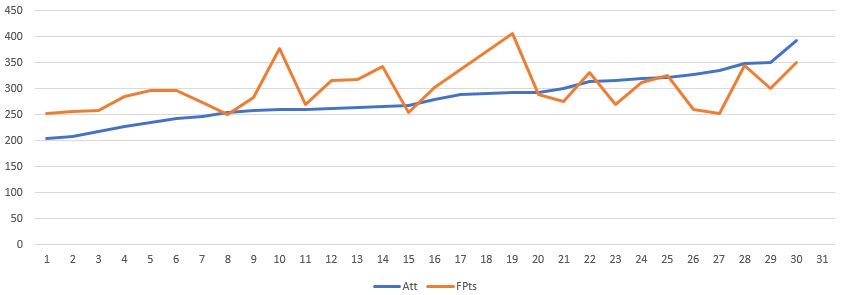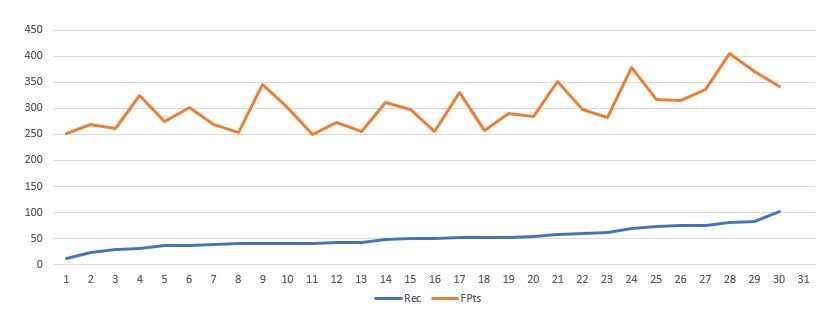Mind of Miller: How to Become an RB1
A couple months ago in an edition of Mind of Miller, I ranked Leonard Fournette as my RB4 in the 2017 rookie class. I’ve since backed off that rather warm take, but when I made it, I had good reason. Both here and on the Twitter machine, I spoke about the counting stat output needed to be an RB1. Using Marshawn Lynch as an example, I showed a 300 carry, 1,400 yard, 12 touchdown, 30 reception back is a top-five runner, but not somebody who belongs in the same breath and David Johnson and Le’Veon Bell.
After the abuse I took for what I thought was a well-made point, I decided I should take a deeper dive into what a high-end running back looks like. Using rushing volume, touchdowns and receptions to paint a picture of RB1s, RB2s, and more, I feel like I have a much greater understanding of what it takes for a player to reach a given level of production. After reading this, you will too.
I conducted my research using the last five years of data from the 50 highest scoring running backs in each season. Unless otherwise stated, every stat I am about to give came from the specific time frame of 2012 to 2016. Using somewhat arbitrary, yet relevant cutoffs, I’ve broken down our subjects into three tiers.
[am4show have=’g1;’ guest_error=’sub_message’ user_error=’sub_message’ ]
High-End Producers (250+ PPR points)
- An average of six running backs per season have scored at least 250 PPR points. None finished below RB8.
- The 30 players in question missed a total of 18 games, or .6 each. They averaged 15.4 games played per season.
- 23 had 250 or more rushing attempts. All 30 had at least 205.
- Only two failed to score at least ten total touchdowns. One of those scored nine, the other eight.
- 28 caught at least 30 passes.
- Only five of the 25 total top-five finishers had fewer than 40 receptions. Those five players averaged 14 touchdowns.
- Every 300+ point scorer had at least 259 attempts, 32 receptions, and nine scores. 13 of these 14 players finished as the RB3 or better.
- 29 of 30 250+ point scorers checked two of the three following boxes: 250+ carries, 50+ receptions, ten+ touchdowns.
There are virtually no surprise names in this group. Devonta Freeman (2015), Knowshon Moreno (2013), Doug Martin (2012) and Alfred Morris (2012) are the ones who may qualify, and even then, Martin and Moreno were both first round picks. While late round running backs do sometimes transcend, the number of one-year-wonders who produce at a high level then disappear is incredibly small.
As the 15.4 games played per season indicates, health is paramount to this level of success. With injuries being so difficult to predict, I have always been one to bet on volume, ability, and upside. I’ll let the torn ACLs fall where they may.
Non-Elite RB1s (200-249 PPR points)
- 75% (30 of 40) who have scored 200+ points ended up as RB1s. 38 finished in the top-15.
- The 40 players missed a total of 29 games, or .73 each. They averaged 15.3 games played per season.
- 15 had 250 or more rushing attempts. 28 topped 200, and all but four ran it at least 147 times. Three of those four caught at least 75 passes. The fourth, David Johnson (2015), scored 12 touchdowns and averaged a billion yards per touch.
- 13 of 40 scored double digit touchdowns. Nobody tallied fewer than five and 33 hit pay dirt at least seven times.
- LeGarrette Blount (2016) was the only player to score more than 12 times and not hit 250 points, managing only 232.9.
- 37 of 40 players in this tier checked two of the three following boxes: 200+ carries, 40+ receptions, seven+ touchdowns.
This is the tier where we see role players break in. Stevan Ridley (2012) and Blount (2016) both landed here while combining for only 13 receptions. On the flip side, this group has four seasons of 75+ receptions, fewer than 150 carries, and no more than nine touchdowns. With only these six instances in five years, it should be noted how difficult it is for a highly specialized role player to end up in the RB1 discussion.
As with the 250+ point guys, health was a huge factor in topping 200 points. Only one player did it while missing at least four games. Four others played 13 and managed to get in. Everybody else missed two or fewer contests.
RB2s (150-199 PPR points)
- No running back has scored under 200 points and been an RB1.
- Every running back who scored at least 150 points finished in the top-27.
- 48 of the 57 players in this group finished between RB13 and RB24.
- The 57 players missed a total of 72 games, or 1.26 each. They averaged 14.7 games played per season. 45 of the 57 missed two or fewer. Nobody missed more than six.
- 31 had 200 or more rushing attempts, 40 topped 150, and only ten failed to reach 100. Of those who missed the century mark, all but two caught at least 52 passes. One of them snagged 40 and scored seven times, the other had 38 catches and eight scores.
- Only four of the 57 tallied ten or more touchdowns. 26 players had five or fewer. The variance in this category is much wider than in the two higher tiers.
- 47 of 57 players in this group checked two of the three following boxes: 150+ carries, 30+ receptions, five+ touchdowns.
With 14 seasons of less than 150 carries and at least 40 receptions, there is even more room for role players in this tier. 13 others managed 198 or more carries and under 25 receptions. Unless such a player is elite in their area of expertise or sees incredible volume, RB2 is their likely ceiling.
In the repeating myself department, players in this group enjoyed relatively healthy seasons, with only 1.26 missed games per individual. Considering I am using cumulative scoring and not points per game, that shouldn’t come as a huge surprise, but it should reinforce how critical good health is to cumulative production.
All that was a lot to digest, but it sets the stage will for our grand finale. To boil it down, let’s combine what we’ve learned and see how it can be applied.
- 94 players topped 200 carries. 85 of them, or 90.4%, finished as a top-24 scorer.
- 131 players topped 165 carries. 122 of them, or 93.1%, finished as a top-36 scorer.
- 24 players caught at least 55 passes. 21 of them, or 88%, finished as a top-24 scorer. All of them finished in the top-28.
- 46 players caught at least 50 passes. 35 of them, or 76.1% finished as a top-24 scorer. 44 finished in the top-36.
- 45 players scored at least ten times. 42 of them, or 93.3%, finished as a top-15 scorer. All made the top-21.
- 82 players scored at least eight times. 72 of them, or 87.8%, finished as a top-24 scorer. All but four were at least top-36.
This shouldn’t come as a surprise, but volume is king. If a player can hit 165 carries, they are all but guaranteed to be at least an RB3. Bump that up to 200 carries, and you are looking at an RB2. With pass catching, 50 receptions makes you an RB3 with near certainty. If we add only five more, you enter RB2 territory.
Interestingly, the correlation between rushing volume and fantasy scoring for high-level producers lessens as you approach 250 carries. At that point, receptions begin to become the main differentiator, hence my concern about Fournette’s ceiling.
The charts below help make my point. The first shows the correlation between attempts and points among 250+ point scorers, the second does the same for receptions and points.


Unlike volume, touchdowns are notoriously difficult to predict. It doesn’t mean the stat should be ignored, as they are an obviously important piece to the puzzle, but if I am concerning myself with trying to project players, I’m spending time on rushing and pass catching volume and leaving touchdowns up to the fantasy gods.
Hopefully this admittedly wordy stat dump gave you a basic idea of what the threshold is for running backs to reach the three levels I laid out. While none of this is likely to change your view on a given player, it should help you understand what you need to get out of them for them to fulfill your expectations. And if nothing else, now you know why I’m not very confident a two down running back will be a top-five producer. Sorry, Leonard.
[/am4show]
- How to Win Without Watching Football - July 22, 2021
- 2018 Summer Sleeper: Chicago Bears - July 9, 2018
- NFL Draft Aftermath: Winners and Losers from the AFC North - June 18, 2018


































































